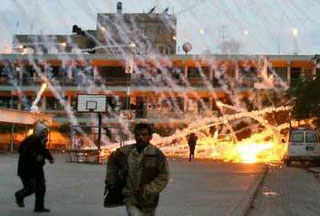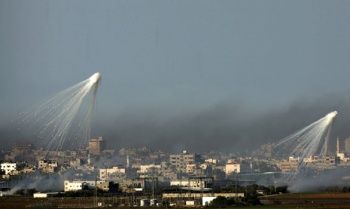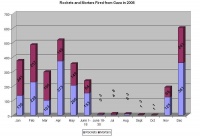Gaza War (2008–09)
Operation 'Cast Lead' - The name assigned by the Israeli military to its 22 day offensive against the Gaza Strip that began on 27 December 2008.
Contents
- 1 Background
- 2 The Israeli Assault on Gaza
- 3 The Aftermath
- 4 Western MSM Coverage of the Conflict
- 5 Amnesty International Report
- 6 Human Rights Watch Report on the use of white phosphorous munitions
- 7 The UN Commissioned 'Goldstone Report
- 8 UN report on investigations, Judge McGowan
- 9 Wikipedia article on this topic
- 10 References
Background
In 2006 an election held in both parts of Palestine (ie Gaza and the West Bank) was won by Hamas, the electoral wing of an Islamist party once noted for suicide bombings. These had ceased in 2005 and . With Israeli supplied arms (including armoured cars) a putsch was attempted against this new government by the losers, the party of Fatah. All elected and many other members of Hamas were rounded up in the West Bank but Hamas members fought off the coup in Gaza and remained in a form of control. Hamas was declared a terrrorist organisation by most of the Western world.
Gaza, from which all the settlers had been withdrawn in 2005, became a hub of militancy from which considerable numbers of home-made rockets were launched into Israel causing occasional casualties. Sporadic control was sometimes exerted by the new (but largely unfunded) government of Hamas while at other times launches were made in its name.
On 19th June 2008 an Egyptian-brokered truce came into effect between Gaza and Israel, though with no mutually agreed text.[2] Israel killed another Palestinian (allegedly preparing to fire a rocket) minutes before the cease-fire came into effect.[3] Israel warned that even a single rocket firing would be considered a violation and they would hold Hamas responsible. There must also be movement towards the release of Gilad Shalit.[4][5]
Gazans understood that, after two weeks of success, Israel would open the crossings and allow normal transfer of goods. Hamas agreed that for its part it would stop rocket attacks from its own armed groups and from others based in Gaza, including Islamic Jihad and Al Aksa Martyrs Brigades.
Hamas imposed its will and imprisoned some of those firing rockets/mortars for short periods. While counts vary somewhat (eg 30 reaching Israel in 4.5 months[6]), all observers agree that the number of firings plummeted from an average of around 380/month in early 2008 to 10s of projectiles in July and August and single figures in September & October combined.
Goods shipments increased by 25% or so but remained at less than 1/5th of what Gazans considered normal. The UN recorded seven IDF violations of the ceasefire between June 20 and June 26, and three violations by Palestinian groups not affiliated with Hamas between June 23 and 26.[7]
On 4 November 2008 Israel entered Gaza and killed 6 Palestinians[8] and there was retaliatiatory firing of 190 rockets in that month. However, on the expiry of the formal cease-fire on 19th Dec 2008, most sources expected it to be renewed.[9][10]
The Israeli Assault on Gaza
On 27 December Israel began a wave of airstrikes against targets within the Gaza Strip with the stated aim of stopping rocket fire. Israeli forces attacked military targets, police stations and government buildings. There was also significant so-called 'collateral damage' though its extent calls that description into serious question. In response, Hamas intensified its rocket and mortar attacks against Southern Israel, reaching the major cities of Beersheba and Ashdod for the first time. An Israeli ground invasion began on January 3, 2009. The war ended on 18 January when Israel declared a unilateral ceasefire followed 12 hours later by Hamas announcing a one-week ceasefire. Israel completed its withdrawal on January 21.
The Aftermath
The invasion left 1,500 Palestinians dead. 13 Israelis were killed - mostly by 'friendly fire'. Tens of thousands of homes were damaged or destroyed as were 15 of Gaza’s 27 hospitals and 43 of its 110 primary health care facilities, 800 water wells, 186 greenhouses, and 10,000 family farms. About half a million people were left without running water and one million without electricity.
Western MSM Coverage of the Conflict
Coverage in the Western mainstream media was, as always in matters involving Israel, appallingly one-sided with the Israeli version of what was happening and why uniformly portrayed as 'understandable' where not sycophantically supportive - the BBC being first among equals in this respect. John Pilgers article 'Gaza Under Fire' [11], published in The New Statesman on 8th January at the height of the Israeli military offensive was an exceptional beacon in the dark. It put matters in the historical perspective of 60 years of Zionist expansion, dispossession and systematic persecution of its indigenous population and lampooned the sycophancy of the Western main-stream media towards the Zionist State with laser accuracy.
Amnesty International Report
In February 2009, Amnesty International published a report entitled "Fueling Conflict: Foreign arms supplies to Israel/Gaza [12]. In company with the Later Goldstone Report (see below), it is commendable for its even-handedness in criticizing both sides. Likewise, in the disparities it reveals. Disparities in quantity, quality, technical sophistication and destructive power is confirmed as absolutely overwhelmingly on the side of Israel, as is the firepower actually used and the damage and death tolls resulting. That start vulgarity 'farting against thunder' sums the matter up accurately.
Human Rights Watch Report on the use of white phosphorous munitions

600+ civilians survived as attack failed to ignite fuel tankers the IDF had been repeatedly warned about.[13]
In March 2009, Human Rights Watch published a report on the extensive use of white phosphorous munitions by the Israeli forces entitled 'Rain of Fire - Israel's unlawful use of white phosphorous in Gaza.[14]
Late in the operation, several obviously humanitarian facilities were hit by White Phosphorus munitions including (from the HRW report Summary, p.3): "... on January 15 ... white phosphorus shells struck the al-Quds Hospital and its administration building run by the Palestinian Red Crescent Society ... Also on January 15, at least three white phosphorus shells struck the main UNRWA compound in the Rimal neighborhood of central Gaza City ... At another well-marked UN facility – a school in Beit Lahiya sheltering roughly 1,600 displaced persons – the IDF air-burst at least three white phosphorus shells on January 17".
UNRWA’s Gaza director John Ging adamantly denied the IDF claim, made by Prime Minister Ehud Olmert to United Nations Secretary General Ban Ki Moon that any Palestinian fighters had entered the compound, let alone fired from it at IDF soldiers.
UN officials said they made dozens of increasingly frantic phone calls with IDF officers as the shells got closer, asking them to stop, and the IDF did not warn UNRWA about Hamas activity in or near the compound. “They should tell us if there are militants operating in our compound or in our area,” Ging said. “The fact that they don’t, we take that as indicative of the fact that there wasn’t.”[15]
The UNRWA shortly issued a statement saying that “Attacks Against the UN in Gaza Must Be Investigated”.[16]
The UN Commissioned 'Goldstone Report
In September 2009, a UN special mission, headed by Justice Richard Goldstone, produced a report accusing both Palestinian militants and Israeli Defense Forces of war crimes and possible crimes against humanity, and recommended bringing those responsible to justice. Israel rejected the report out of hand. The UN Human Rights Council has endorsed the report with heavy criticism of Israel.[17]
Goldstone "retraction"
7 months later Judge Richard Goldstone (after intense personal pressure) wrote an article hailed by supporters of Israel as a retraction of the report that bears his name.[18]
The statement was made alone and was repudiated by the other members of the committee[19] and refered to a change in his view that Israel, as policy, had deliberately targetted civilians. None of the specific allegations of war-crimes aimed at Israel and at Gaza were mentioned. [Roughly speaking, there were six other broad findings of serious war-crimes in the Goldstone report (1) Siege on Gaza (2) Attack on political institutions and buildings of Gaza (3) taking insufficient measures to protect civilians (4) "indiscriminate" attacks (as distinct from "deliberate" attacks) (5) illegal weapons, such as white phosphorous and flechette missiles and (6) deliberate destruction of civilian infrastructure.]
Goldstone's three colleagues cited the final UN report on the Gaza war,[20] written by a follow-up committee led by Judge Mary McGowan Davies, which criticised Israel for the slow pace with which it conducted its investigations and for its refusal to address some of the most serious allegations about its conduct.
UN report on investigations, Judge McGowan
The final UN report on the Gaza war, written by a follow-up committee led by Judge Mary McGowan Davies,[20] This committee was refused any cooperation by Israel or access to Gaza - but was able to hold video-teleconferences with victims. The Palestinians amongst whom recounted their first-hand experience with Israeli criminal investigations. These witnesses detailed their frustration with the Israeli investigating authorities and gave articulate voice to their perception that Israeli justice mechanisms were completely ineffective and non-existent. The Committee criticised Israel for the slow pace with which it conducted its investigations and for its refusal to address some of the most serious allegations about its conduct.[21]
Wikipedia article on this topic
Wikipedia has a substantial article on the "Gaza War" [22] with many more references than this one but with a strong bias towards sources known to be pro-Israel eg the first three references are cited to claim there there was an "Israeli tactical military victory" and the same references are used extensively throughout the rest of the article. Those references include almost none of the information we'd expect to find, the first is "New Tactics Yield Solid Victory in Gaza" from Aviation Week (cited 7 times),[23] and second is "Hamas seeks new doctrine after Gaza War failures" Jerusalem Post.[24] The first "main-stream news source" is an article from the New York Times which also avoids mention of anything readers might expect to see "Hamas Shifts From Rockets to Culture War".[25]
The Wikipedia article fails to mention the (equally critical) final UN report on the Gaza war by a committee led by Judge Mary McGowan Davies and reporting in March 2011.[20]
The actual Goldstone report is cited just 3 times at the Wikipedia article - while "challenges" (and Judge Richard Goldstone's supposed "retraction") get around 3 times more attention.
Past experience suggests that this Wikipedia article will never even reflect what a predominance of Western observers said on the subject.
References
- ↑ Summary of Rocket Fire and Mortar Shelling in 2008. (pdf) Intelligence and Terrorism Information Center. Retrieved January 14, 2009. pp. 5–7. Drop in rocket fire calculated from data provided in report.
- ↑
{{URL|example.com|optional display text}} - ↑
{{URL|example.com|optional display text}} - ↑ Top Defense Ministry official: If Shalit is not released, Rafah stays closed, YNET, June 16, 2008
- ↑ Israel confirms Hamas ceasefire deal Independent, June 18, 2008.
- ↑ "Between June 19 and November 4, 20 rockets (three of which fell inside the Gaza Strip) and 18 mortar shells (five of which fell inside the Gaza Strip) were fired at Israel." Right-side News, 31st Dec 2008.
- ↑ "FACTBOX-Israel, Palestinians trade blame for truce violations". Archived from the original on June 29, 2008. Retrieved June 26, 2008.Page Module:Citation/CS1/styles.css must have content model "Sanitized CSS" for TemplateStyles (current model is "Scribunto").
- ↑ Gaza truce broken as Israeli raid kills six Hamas gunmen, Guardian, Rory McCarthy, 5 November 2008
- ↑
{{URL|example.com|optional display text}} - ↑ Israeli leaders 'to topple Hamas' BBC News. 2008-12-22. Retrieved 2009-01-23.
- ↑ Document:Gaza Under Fire - John Pilger
- ↑ File:Amnesty-Gaza 19194.pdfFuelling conflict: Foreign arms supplies to Israel/Gaza
- ↑ Goldstone Report, p.133: Late in the conflict, 7 White Phosporus and 3 HE shells strike UNRWA compound where over 600 civilians shelter. "Fuel tankers parked above ground had around 49,000 litres of fuel in them. In addition to the obvious and immediate risk of fire in these circumstances, the compound also stored large quantities of medical supplies, food, clothing and blankets in the warehouses." 25 September 2009.
- ↑ File:Rainoffire.pdf - Israel's unlawful use of white phosphorous in Gaza
- ↑ “Israel Shells U.N. Site in Gaza, Drawing Fresh Condemnation,” New York Times, January 16, 2009.
- ↑ “Attacks Against the UN in Gaza Must Be Investigated” UNRWA statement, January 24, 2009.
- ↑ The "Goldstone" Report of the United Nations Fact-Finding Mission on the Gaza Conflict Judge Richard Goldstone, Professor Christine Chinkin, Ms. Hina Jilani and Colonel Desmond Travers. 25 September 2009.
- ↑ "Reconsidering the Goldstone Report on Israel and War Crimes" 1st Apr 2011.
- ↑ Gaza Report Authors Rebuke Goldstone Sydney Morning Herald. 16th April 2011.
- ↑ a b c UN Committee to assess investigations for compliance with international standards of independence, impartiality, effectiveness, thoroughness and promptness. Judge Mary McGowan Davies. 18 March 2011.
- ↑ Gaza Report Authors Rebuke Goldstone Sydney Morning Herald. 16th April 2011.
- ↑ Wikipedia on "Gaza War" - marked "neutrality disputed" as of Sept 2011. Easily recognisable hasbara.
- ↑ "New Tactics Yield Solid Victory in Gaza". Aviation Week. (1st cite at Wikipedia, used 7 times).
- ↑ "Hamas seeks new doctrine after Gaza War failures" Jerusalem Post (2nd cite at Wikipedia, used 8 times).
- ↑ "Hamas Shifts From Rockets to Culture War New York Times, 24 July 2009.

